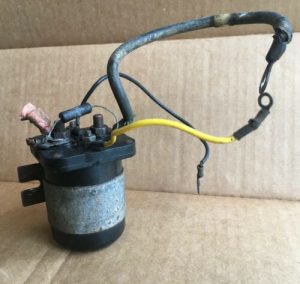Is My Golf Cart Solenoid Bad?
Before trying to understand the symptoms of a solenoid going bad in golf carts, let’s review what they are supposed to do when operating properly.
In actuality, a solenoid is a shape technically speaking—a shape in which a coil’s length is greater than its diameter. This describes the smaller motor that rides on the starter in engine starters because it has a wire that has been wound tightly around a metal bar.
For a gas golf cart, the function of the solenoid in a golf cart motor is to use a small amount of electricity (made possible by turning on the ignition switch) to close two heavy-duty contacts that are needed to get the starter turning over.
The same principles apply while using an electric golf cart. 
It works like this:
The solenoid receives a modest quantity of electricity when the ignition key is turned. The solenoid uses that little energy to close two heavy-duty contacts on the starter, allowing a big surge of electricity to flow through it.
The solenoid also sends a pinion gear forward, which is the device the starter uses to turn over the flywheel. When the engine starts, a spring returns the pinion gear to the starter, where it idles until the time comes when you need to start the engine again.
How Do You Know If Your Golf Cart Solenoid Is Bad?
When the ignition switch is turned off, the starter may still run in a gas golf cart if the bigger contacts fail to disengage.
Additionally, if the starter is repeatedly engaged, the spring that pulls the pinion back to its resting position may wear out. (Starters are intended to move the flywheel before backing away and disengaging.)
The solenoid could simply wear out due to overheating, just like any switch that depends on wiring. This could prevent it from retrieving the pinion gear.
Knowing that, how do you know when the solenoid starts to fail and what’s happening?
On a gas golf cart, the starter failing to engage is the most typical symptom. As a result, the engine won’t turn over, and all you hear is a series of pointless clicking noises.
The solenoid failing to send energy to the controller when the vehicle’s ignition is turned on is the most typical sign of an electric golf cart problem.
The solenoid clicks on and off with the ignition switch under normal working circumstances. In most cases, a solenoid in trouble won’t click.
There are two possibilities here. Possible reasons for the solenoid not receiving enough electricity to function include poor connections, a weak battery, or a worn-out coil.
Second, excessive heat or exposure to strong current could cause the contacts to start losing their elasticity. This necessitates constant usage of the starter, so it needs to be rectified as soon as humanly possible. Both the solenoid and the starter will require replacement if not discovered in time.
There are two possibilities here. Possible reasons for the solenoid not receiving enough electricity to function include poor connections, a weak battery, or a worn-out coil.
Check out 4 reasons to buy a golf cart.
Second, excessive heat or exposure to strong current could cause the contacts to start losing their elasticity.
This necessitates constant usage of the starter, so it needs to be rectified as soon as humanly possible. Both the solenoid and the starter will require replacement if not discovered in time.
How To Check Your Golf Cart For A Bad Solenoid
Your best bet is to call a certified golf cart mechanic to check for you. However, it you want to do it yourself, here is what you need to do:
First, remove the cables from the starter (gas) or controller that link to the bigger solenoid terminals before testing the starting mechanism (electric).
Use electrical tape to seal the cable ends as you work to prevent accidental contact between them or accidental connection through a metal conductor from creating a circuit.
By doing this, you can be sure that the car won’t start while the solenoid is being tested.
Once the cables have been safely detached, switch off the key and tap each large terminal with the probes of a voltmeter set to the ohms setting. Get a reading of zero, please.
Try it once more with the key in the ignition and the cart moving ahead (not reverse).
In order to hear a clicking sound, step on the gas.
Look for a reading that is less than 0.4 ohms if you hear a clicking sound. Higher readings indicate a defective solenoid that has to be replaced.
If the solenoid on an electric golf cart is silent—that is, it is not clicking—set the voltmeter to DC volts in the 200 range.
First, start the engine and check the smaller terminals for a reading. If nothing appears, then drive forward by applying the accelerator.
If the needle does not move, the solenoid is not the issue. If it leaps and shows full voltage, the solenoid is the issue and needs to be changed.
If you need help, please contact Fairway Golf Car Mobile Services today!
